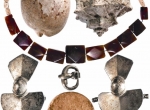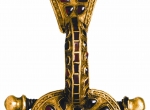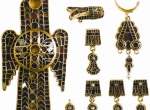Ostrogoths
Ostrogoths, Greutungi, steppe Goths. The heyday of Cherniakhiv Culture was during the second half of the 3rd and 4th century, under Ermanaric (Hermanaric), the last king of the O. before the invasion of the →Huns , from the royal house of the Amali. Cherniakhiv culture is known from not less than 3000 cemeteries and settlements, its distinctive traits include the tradition in which men’s graves were not furnished with weapons and tools, women’s dress accessories included a pair of matching brooches, silver or bronze, with a half-round head, a belt buckle, and a necklace of glass and amber beads, a biritual burial rite and basically, non-deposition of iron objects in graves. Many of these attributes, e.g., the forms of metal dress accessories and jewellery, are observed earlier in →Wielbark Culture . Large settlements of Cherniakhiv Culture are also known, with great hall houses and with smaller dugouts, used for storage and production. A regular find in all the sites of Cherniakhiv Culture is a large quantity of fine quality wheel-turned pottery. The kingdom of Ermanaric supposedly extended to the Baltic and the forest zone of East Europe, but it would be more correct to speak of a Gothic domination rather than of an actual state organism.
The invasion of the →Huns in 375 precipitated the fall of Cherniakhiv Culture. In late 4th century its settlement is fragmented, with some pockets found as far as the Don River, the Crimea and the Caucasus. These would be the relics of the →Goths who after being routed by the Huns did not set off to the west. In the eastern area of Crimea, on the Kerch Peninsula, at Panticapaeum, the capital of the Bosporan Kingdom, many elite O. and Danish graves were discovered, containing gold objects decorated with garnets and almandines in the →Polychrome Style . The style originated on the Black Sea and in the eastern Mediterranean, and ornaments and harness fittings of this sort were popular among the barbarians →Goths . From the mountainous area of Crimea several cemeteries with catacomb graves are known, some attributable to the O. who, according to Procopius of Caesarea, lived in the region called Dory where they had taken shelter prior the Hunnic invasion. The presence of →Goths in Crimea is confirmed until the 18th century.
In 379/380 some of the O. were made to settle in Pannonia between the Drava and the Sava rivers. In provincial Roman cemeteries we find graves with barbarian objects and, to the east of the Danube, graves with ornaments in Cherniakhiv style. Nevertheless, as a rule the Goths in the provinces soon became Romanized. Numerous graves discovered in the Middle Danube region contained very rich furnishings among them, nomad and East Germanic dated to the late 4th and to the first half of the 5th century, attributable to the O., Scirii, →Heruli , Rugii and →Gepids. The burial of a woman discovered at Untersiebenbrunn in Lower Austria, with Roman ornaments but also East Germanic ones, documents the fashion of elite barbarian women in central and Western Europe which is referred to as Danubian or the Untersiebenbrunn horizon →Sösdala-Untersiebenbrunn Style.
In 405 O., a force of some 200 000 men under Radagaisus, appeared in Italy but were routed and their leader perished. After the Battle of Nedao and the defeat of the →Huns in 456 the kingdom of the O. was established in Pannonia, as allies of Byzantium, in return for an annual tribute. Theodoric, the son of one of three Ostrogothic kings, later known as Theodoric the Great, spent ten years in Constantinople as a hostage to guarantee the peace with Ostrogoths. As an eighteen year old he returned to his people and after a victory over the Sarmatians was proclaimed king. Unable to sustain themselves in Pannonia where the Roman economic system had been destroyed the Goths were led by Theodoric on a several years’ trek across the Balkan Peninsula and in 488, with the permission from Emperor Zeno, made for Italy to settle there. After clashes with Odoacer and his murder, from 493 the Ostrogoths became rulers of Italy, Dalmatia and the Alpine region of today’s Austria and eastern Switzerland. The capital of the Ostrogoths acknowledged by Byzantium was Ravenna.
Theodoric the Great kept the Roman system of administration and made a series of useful alliances with the Germanic kingdoms of the →Franks , →Thuringi, →Vandals in Africa and the →Visigoths . The O. ruler respected Roman culture and had as a member of his court →Cassiodorus, senator and historian, author of the now lost history of the →Goths .
After the death of Theodoric in 526 the system of alliances broke down and Emperor Justinian sent an army under Belisarius to take back Italy. After a year-long siege of Rome by the Goths they were defeated in 552 in the Battle of Busta Gallorum in the Apennines in which their last king, Totila, was slain. In 561 Verona, the last stronghold of the Goths, fell and Italy found itself for a brief time, until the coming of the Langobards in 568, under the rule of Rome of the East.
From Italy, especially its northern region, a small number of O. graves is known. In men’s graves traditionally there are no weapons and the female dress accessories follow the model which may be traced back to the Cherniakhiv Culture (fig. 1-3.). These rich female burials mostly date from the earliest phase of Ostrogothic presence in Italy and a part of them may even be linked to the Scirii of Odoacer. There is also a number of hoards of gold and silver ornaments, from Reggio Emilia, Desana and Domagnano (fig. 4.). Graves with very modest furnishings are an expression of steady Romanization of the O.
MM
Literature: V. Bierbrauer, Die ostgotischen Grab- und Schatzfunde in Italien, Spoleto 1975; J. Strzelczyk, Goci – rzeczywistość i legenda, Warszawa 1984; R. Wołągiewicz, Die Goten im Bereich der Wielbark-Kultur [in:] Peregrinatio Gothica, Archaeologia Baltica 84/85, Łódź 1986, p. 63-98; M. Kazanski, La diffusion de la mode danubienne en Gaule (fin du IVe siècle - début du VIe siècle): essai d’interprétation historique, Antiquités Nationales 21, 1989, p. 59-73; P. Périn (ed.), Gallo-Romains, Wisigoths et Francs en Aquitanie, Septimanie et Espagne, Actes des VIIe Journées internationales d’Archéologie mérovingienne Toulouse 1985, Rożen 1991; V. Bierbrauer, Archäologie und Geschichte der Goten vom 1.-7. Jahrhundert. Versuch einer Bilanz, Frühmittelalterliche Studien 28, 1994, p. 51-171; V. Bierbrauer, Das Frauengrab von Castelbolognese in der Romagna (Italien). Zur chronologischen, ethnischen und historischen Auswertbarkeit des ostgermanischen Fundstoffs des 5. Jahrhunderts in Südosteuropa und Italien, Jahrbuch des Römisch-Germanischen Zentralmuseums Mainz 38, 1995, p. 541-592; A. Kokowski, Schätze der Ostgoten, Stuttgart 1995; V. Bierbrauer, Les Wisigoths dans le royaume franc [in:] F. Vallet, M. Kazanski, P. Périn, (eds.), Des royaumes barbares au Regnum Francorum. L’Occident à l’époque de Childéric et de Clovis (vers 450 – vers 530). Actes de XVIIIes Journées Internationales d’Archéologie Mérovingienne, Bulletin des Antiquités nationales 29, 1997, p. 169-200; J. Tejral, Neue Aspekte der frühvölkerwanderungszeitlichen Chronologie im Mitteldonauraum [in:] Tejral, J., Friesinger, H., Kazanski, M. (eds.), Neue Beiträge zur Erforschung der Spätantike im mittleren Donauraum, Spisy Arheologického Ústavu AV ČR Brno 8, Brno 1997, p. 321-392; A. I. Ajbabin, Etničeskaja istorija rannebizantijskogo Kryma, Simferopol 1999; W. Ebel-Zepezauer, Studien zur Archäologie der Westgoten vom 5.-7. Jh. n. Chr, Iberia Archaeologica 2, Mainz am Rhein 2000; H. Wolfram, Die Goten. Von den Anfängen bis zur Mitte des sechsten Jahrhunderts, München 2001; H. Wolfram, Historia Gotów, Warszawa-Gdańsk 2003; M. B. Ščukin, Gotskij put’. Goty, Krym i černjachovskaja kul’tura, Sankt-Peterburg 2005; J. Kolendo, Plemiona Pomorza w starożytności [in:] Nowakowski, W. et all. (eds.), Goci i ich sąsiedzi na Pomorzu, Koszalin, 2006, p. 17-33; M. Ščukin, M. Kazanski, O. Sharov, Des les goths aux huns: Le nord de la Mer Noire aus Bas-empire et à l’époque des grandes migrations, BAR International Series 1535, Oxford 2006; V. Bierbrauer, Neue ostgermanische Grabfude des 5. und 6. Jahrhunderts in Italien, Acta Praehistorica et Archaeologica 39. Festschrift W. Menghin, 2007, p. 93-124; A. Kokowski, Goci. Od Skandzy do Campi Gothorum (od Skandynawii do Półwyspu Iberyjskiego), Warszawa 2007; M. Mączyńska, Światło z popiołu. Wędrwówki ludów w Europie w IV i V w., Warszawa 2013, p. 217-228, 230-234.
-
 full resolution
full resolution
Fig. 1. Furnishings of a woman’s grave, Cherniakhiv Culture, from the locality Sad (Sumy). Photo I. J. Rojčenko, Museum in Vynnitsia, Ukraine.
-
 full resolution
full resolution
Fig. 2. Gold brooch from the Nizhyn Hoard, Ukraine, State Hermitage Museum (A. G. Furas’ev, Epocha merovingov: orly Rima i vorony Votana, Saint Petersburg 2007).
-
![Fig. 3. Gold ornaments in Polychrome style from catacomb graves in Gospitalna Street in Kerch, Crimea, State Hermitage Museum (I. P. Zasecskaja, Kerč, via Gospital’naja [in:] I Goti. Milano 1994, p. 116-123).](http://www.mpov.uw.edu.pl/userfiles/pl/generated/thumbs/150x110_1/Badania/Thesaurus/ostrogoci3.jpg) full resolution
full resolution
Fig. 3. Gold ornaments in Polychrome style from catacomb graves in Gospitalna Street in Kerch, Crimea, State Hermitage Museum (I. P. Zasecskaja, Kerč, via Gospital’naja [in:] I Goti. Milano 1994, p. 116-123).
-
 full resolution
full resolution
4. Gold ornaments from the Domagnano Hoard, San Marino (W. Menghin 1987).


